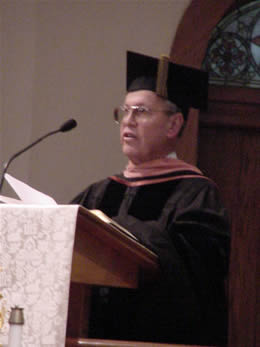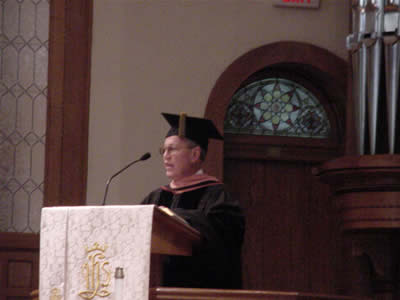
Harold Schiffman´s Commencement Address
The School of Music of The University of North Carolina at Greensboro
14 May 2004
A CONFLUENCE OF VARIOUS MUSICS First of all, let me express my enormous pleasure in being invited to address you today. I consider it a distinct honor. I congratulate you, graduates, on your achievements, and I congratulate you on your choice of university. You and I are privileged to be a part of a distinguished and long-standing musical tradition. My relationship with UNCG goes back to my childhood growing up in Greensboro; I won´t say how many years ago! While I never matriculated here (at the time when I might have, I was of the wrong gender!); nonetheless, UNCG, then the Woman´s College of the University of North Carolina, nurtured me musically in many ways. I did study composition with a composer on the faculty, Professor Eliot Weisgarber, when I was in high school. And some of the very first public performances of my own music took place in the Brown Music Building. I went frequently to concerts in Aycock Auditorium, hearing many distinguished artists including Sergei Rachmaninov, Josef Hoffman, Joseph Szigeti, Nathan Milstein, Claudio Arrau, the Philadelphia Orchestra under Ormandy, The Minneapolis Symphony under Leinsdorf, to name but a few. And the annual Arts Forum concerts in the School of Music in the 1940s and 50s provided a wonderful and unique opportunity to hear new music, and to come into contact with major guest composers such as Randall Thompson, Howard Hanson, Bernard Rogers, and Roger Sessions. For all of these things I am very grateful. My topic today is “A Confluence of Various Musics,” particularly the classical and the folk, but also the popular. This is a thought that comes to me as I consider differences between the musical situation in America nowadays, and that when I was at your stage of the game, graduating from one degree program or another. Some of you will go on to further study, some will enter into professional musical careers, and some will choose other endeavors as enlightened amateurs of music in the original and best sense of that word. And all of you will derive lifelong benefit from the experience of a “full-service” music program with curricula far more varied and inclusive than those which were available in my day. Thus, the choices open to you are vastly expanded. Fifty years ago musical training was basically classical. Jazz, for example, was not thought to be a proper object of academic inquiry. Today, you have an outstanding jazz program here. Music therapy was in its infancy, and music theater was barely admitted alongside opera. Church music was proper in the old days, but did anyone extend that discipline to include gospel? And folk music, especially our own, but also that of other lands, was, at best, an extra-curricular activity. All of these are available to you now. And all of these are musics that speak to people. This is important, for though we live in troubled and uncertain times, I fervently believe that music has the spiritual power to save the world if we will but let it. The eminent folklorist and fiddler, Alan Jabbour, a specialist in Appalachian fiddle tunes and, incidentally, a member of your School of Music´s National Advisory Board, recently remarked “I believe this is a magic moment of convergence for classical music and folk music in America. I feel the impulse on every hand....” I am convinced he is absolutely right if for no other reason than that I have found this convergence, this confluence, happening in my own music more and more over the last ten years or so. But there is other evidence as well. We have known for a long time that American popular music, especially jazz, but also blues and rock, has spread all over the world, particularly since World War II. Well, now there is a sort of “lend-lease” of folk music going on. For example, we hear quite a bit of Scottish and Irish folk music, both instrumental and vocal, in this country nowadays. This is not exactly a recent development; after all, music from those regions forms the basis for much Appalachian fiddle music as well as other types of “old-time music” extending well back into the eighteenth and nineteenth centuries, and deriving from Irish and Scottish settlers in the mountains. But what is recent is that Celtic musics are being performed by American musicians in popular venues such as bars and pubs. At the same time, the American descendents of those tunes are being returned overseas, played by local musicians there. Bluegrass bands are springing up all over Europe (I heard an outstanding one in Budapest recently) and even in Japan, while the same phenomenon is occurring with gospel and other forms of folk music. Furthermore, European and Japanese luthiers are producing excellent examples of that very American instrument of African ancestry, the banjo, as well as folk guitars and mandolins. Much of this I am sure can be ascribed to modern technology: ease and speed of communication and travel, readily and internationally available compact discs, and, of course, the internet. But it wouldn´t happen if there were not a desire for it on the part of music lovers. Of course, any student of music history knows that there has always been a sort of convergence of the classical and the folk in the music of both America and Europe. One has only to think of nationalist schools of composers of the nineteenth and twentieth centuries. Often this use of folk idioms seems to me somewhat artificial and contrived, and sometimes, politically motivated. But what strikes me as interesting and exciting and healthy today about what I term a “confluence” is that it appears to happen naturally, without necessarily involving a conscious choice: two musics flowing along together, combining and interconnecting, and occasionally separating. I can recall from my student days immediately following the second world war, that “modernism” was the trendy thing, and “modernist” composers were not supposed to allow folkish music into their work (despite Stravinsky and Bartok) for fear that it might sound appealing! One was expected to use serial techniques, aleatory procedures, tone clusters, unusual instrumental gimmicks, unresolved dissonance, and the like. There was an incident that occurred in the mid-1950s, when I happened to be organizing an informal concert series of new music, that is a case in point. A young composer had submitted a lovely, somewhat impressionistic song of only fourteen bars. I had arranged for an outstanding singer and a brilliant pianist (some of you would no doubt recognize their names, so I won´t tell you!) to perform the piece. At the very last minute, the composer withdrew it apparently afraid his peers might find it old fashioned and make fun of it, as if it were normal to make fun of beauty.  Well, I suppose the point of all of this is that you don´t have to choose one music to the exclusion of others. And you don´t have to be afraid of appreciating beauty. All musics are there for you. So embrace them. And continue to learn all you can. Now, graduates, this is my challenge to you: as you go into your musical futures, if you are a performer, play or sing what you love; if you are a composer, write a music that you can love; if you are a scholar, study a music that not only interests you, but that you can also treat with affection; if you are going to be a teacher, your students will find interesting and convincing a music that you clearly love and enjoy, and about which you are enthusiastic. And, as a listener, rely on your own good taste and judgment. You don´t need to worry about “isms and styles.” As composer and critic Virgil Thomson once observed, “Style is not something you do; style is something you have.” So thank you very much for listening. I wish you all the very best of everything in life, and may the spirit of music always be with you! Harold Schiffman |
| | | Home | | | Bio | | | Works | | | Incipits | | | Discography | | | Reviews | | | News | | | Links | | | Photos | | | Contact | | | Search | | |
Banner photo: Snowbird Mountains at dawn, Graham County, North Carolina (October 26, 2005) |
